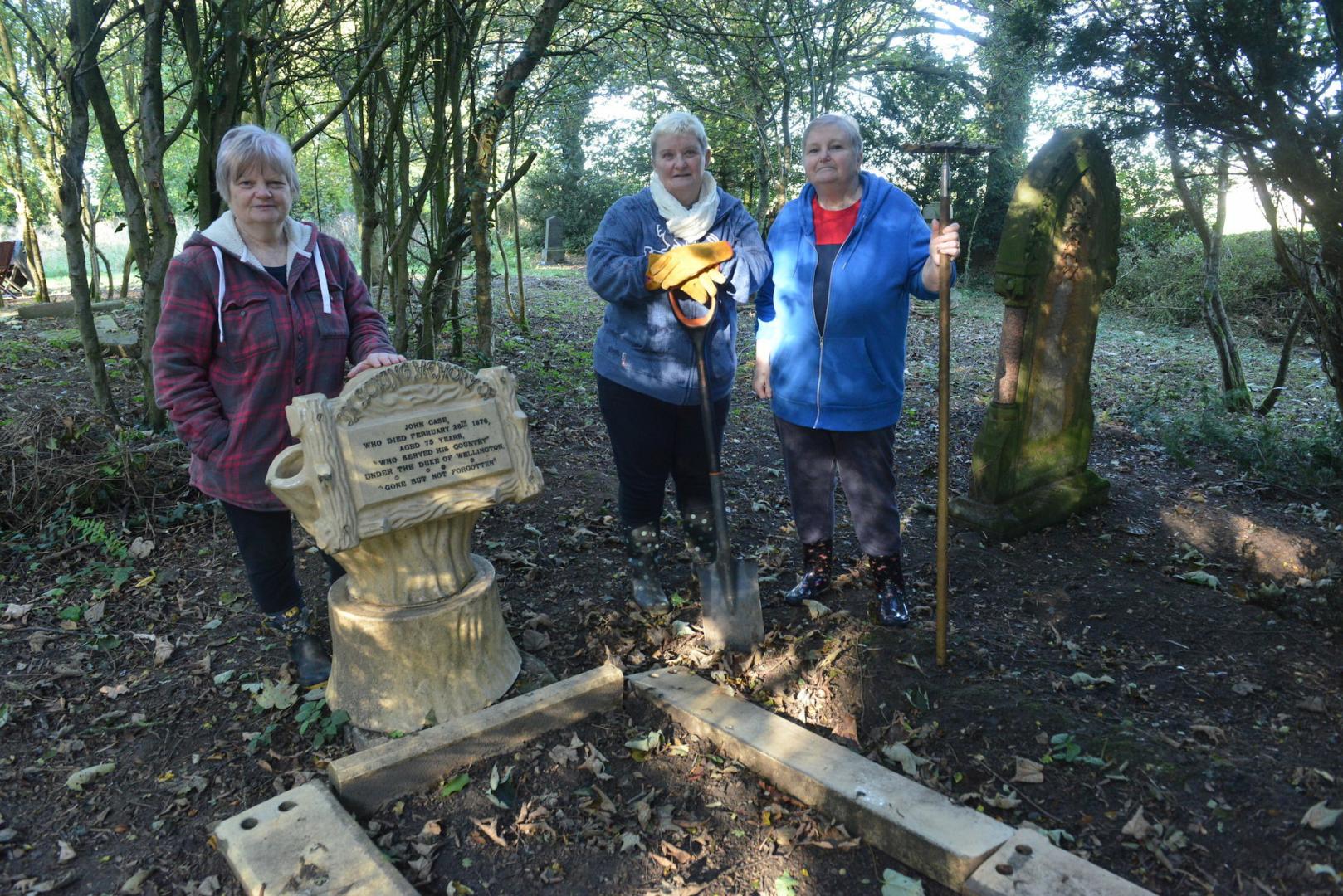The work of three sisters to clear out part of a cemetery left for nature to reclaim for decades has unearthed some remarkable connections between Evenwood and the rest of the world. Martin Paul reports
EFFORTS to uncover an overgrown part of Evenwood’s cemetery are unearthing connections across the globe.
Part of the graveyard, with headstones dating back to 1860, has been closed “and left to the wild” for more than two decades.
Now work by three sisters to clear it has uncovered the resting place of a soldier who served under the Duke of Wellington and a monument to several generations of the prominent Emerson family.
It has also revealed how the village has strong connections to people living in America, Canada, South Africa and New Zealand.
The clean-up effort began by chance early in the spring when Aline Waites went in search of the grave of her great grandparents Benjamin and Hannah Arkless.
She said: “I thought my great-grandparents would have been down here with it being the early 1900s when they died. Walking round all I could see was the top [of something]. I thought what is that? It literally was like being in a jungle.”
Battling through the overgrowth she came across a memorial.
Ms Waites said: “That monument down there is for Wade Emerson, who ran the local bus services for years.”
She added that, uniquely, every generation of the Emerson family, from the early 1800s, had a son named Wade, and the current Wade Emerson now lives in Guernsey.
She roped in her sisters Dawn Fox and Joy Gallimore, along with brother-in-law Stuart Fox, to help remove the weeds and plants that had taken over and soon found an elaborate headstone marking the resting place of a John Case, along with a border which were collapsed and in pieces.
Ms Waites said: “The headstone said he fought under the Duke of Wellington and everything was just strewn everywhere. We have tried to put it together.
“The top comes off – that was laid down and the other part was upside down. It was such a shame. If anything, it should be out in the open so people can see it.”
To date, the sisters have uncovered 64 graves, and each one has been researched by Ms Waites.
She said: “When you put the information into ancestry.co.uk about the person, the name and the dates, sometimes it opens the [family] trees and you can go and have a look at what relation they are.
“If anyone has got them in their tree, I’ll email them and send them a photograph of the headstone.”
The results have revealed incredible stories, including the family plot of Methodist minister George Maddison and his wife Elizabeth, along with two of their children who died in infancy.
Ms Waites got in touch with their great-great-grandson Gavin – a medical doctor living in New Zealand – who revealed the story of his great-uncle. He wrote: “One of their sons, also George, was a Methodist minister too.
“He was stabbed in the neck in 1906 in a riot in Johannesburg, South Africa, [during] the Bambata uprising. It made it into the news in the UK and was mentioned in parliament.
“I grew up in South Africa and came to New Zealand in 1993.”
Another connection was made through the grave of four-year-old Olive Nelson Cooper, who died on April 6, 1895.
Ms Waites found her great-nephew Reid Cooper, now living in Des Moines, Iowa, USA. He was overjoyed at receiving a photo of the headstone, as he had been searching for it for many years.
He wrote back saying: “It’s amazing work that you and your merry band of family and friends are doing to clean up this neglected part of the cemetery and to restore some dignity and attention to those who have been buried there – neglected and lost to history.”
He went on to give a detailed background to the Cooper family’s historic connections to the Durham coalfields and how part of the family came to live in the US.
Ms Waites’ family arrived in the area in the early 1800s and originally settled at The Gill, in Ramshaw, which at the time was known as Little Ireland because of the number of Irish who had moved there.
Two of her great-uncles, John William Arkless and George Thomas Cox, are listed on the cemetery’s grade-II listed war memorial, both having died in the First World War.
As for her great-grandparents’ grave, it was later found in a part of the cemetery that continues to be maintained by Durham County Council.
Had Ms Waites found it earlier, she and her sisters may never have rediscovered a rich part of the village’s history, nor its connections around the world.
Of the early work they did, Ms Waites’ sister Dawn said: “There was ivy, holly – everything you can think of.
“The brambles were about waist height, they have all be strimmed down.
“They were all hidden and dark, we are getting them back out into the light.”
As part of clearing out, the sisters are also creating new spaces for wildlife to thrive, and with the woodworking skills of resident Ian Sowerby, have installed boxes for birds, bats and hedgehogs.
They have also called on the expertise of Maddie Benton, from the Environment Agency, who is licenced to ring birds, to ensure the cemetery remains a haven, not just for those laid to rest, but for the animals too.






